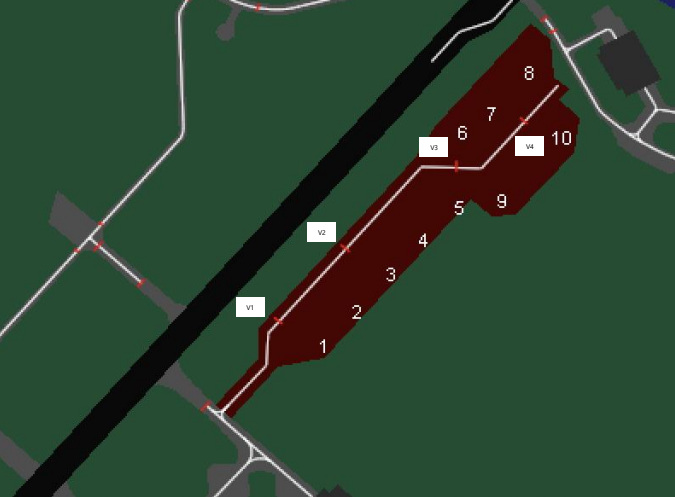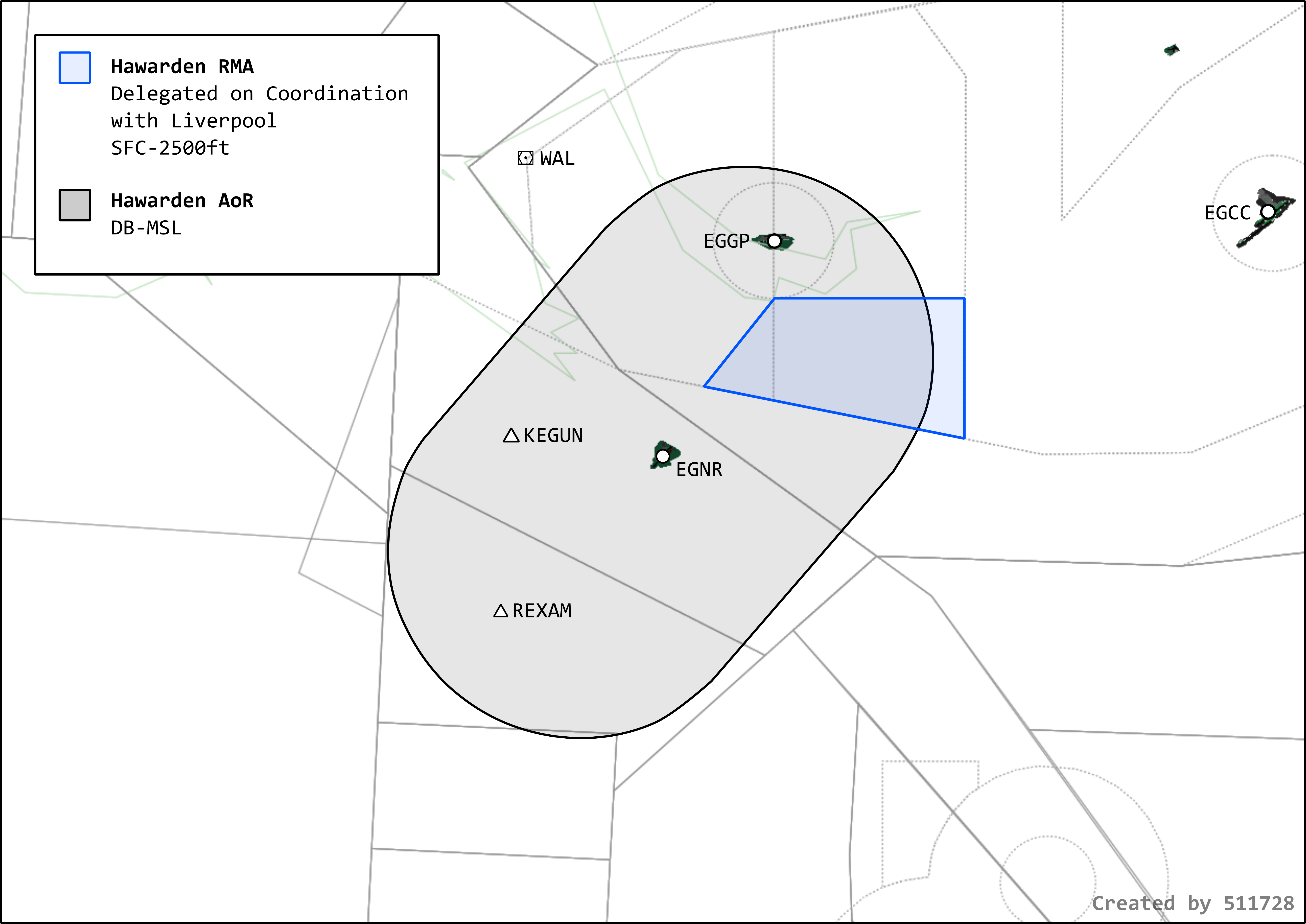¶ EGNR Hawarden Aerodrome Procedures
NOT FOR REAL WORLD USE
¶ General
¶ ATC Positions
| Position | IVAN Callsign | RT Callsign | Frequency |
|---|---|---|---|
| AIR | EGNR_TWR | Hawarden Tower | 124.955 |
| INT | EGNR_APP | Hawarden Radar | 120.055 |
¶ Aerodrome Control
¶ Runway Selection
Runway 22 is the preferred Runway when the tailwind component is 5 knots or less.
¶ Altimeter setting
Departing aircraft are to be given the Hawarden QNH prior to take-off.
Arriving aircraft below the transition level are to be given the Hawarden QNH.
Aircraft entering the aerodrome traffic circuit are to operate on the Hawarden QFE.
Hawarden QFE = QNH - 2 hPa
¶ Transition Altitude
5000 ft
¶ Transition Level
By ATC.
¶ CAT II/III Operations
CAT ll/lll Operations not available.
¶ Low Visibility Procedures
Low Visibility Procedures (LVPs) are in force when:
- visibility 1639 M or less;
- When Visibility 800 M or less - operations restricted to one aircraft movement at a time;
- When Visibility 400 M or less - all airfield operations cease until visibility increases above 400 M.
¶ Restrictions
- Pilots should be informed by ATIS Broadcast or on frequency when LVP’s are in force.
- Increased approach spacing should be used between arrivals.
¶ AIR Control
¶ Responsibilities
- Absolute authority over all movements on the active runway and its access points.
- Aircraft within, and in the vicinity of, the Hawarden ATZ and aerodrome traffic circuit.
- All aircraft ground movements on the manouvering area.
- Clearance Delivery and the issuing of ATC departure clearances.
- Requesting clearances and releases for departing aircraft from Hawarden Radar.
¶ Clearance Delivery
Hwarden has no established Standard Instrument Departures (SID’s). Instead, Hawarden departures should be cleared via the Standard Outbound Clearance (SOC). The Standard Outbound clearances can be found in the XU Quickview or UK AIP.
Departure clearance’s should be requested from Hawarden Radar (INT). AIR will then relay this clearance to the aircraft using the following phraseology:
”Aircraft Callsign, Controller Callsign, After Departure, “Cleared to join controlled airspace” (Standard Outbound Clearance), Squawk [SSR Code].
“BGA415F, Hawarden Tower, Cleared to Join controlled Airspace, REXAM 5 Departure, Squawk 2204”
¶ CPDLC/ DCL
Datalink clearances are not in use at Hawarden.
¶ Releases
All departures from Hawarden except for departures remaining in the visual circuit require a release from Hawarden Radar (INT).
¶ Runway Procedures
¶ Backtrack
Due to the unique layout of Hawarden, Departures may require a full length backtrack of Runway 04 or 22.
“BGA415F, Via E1, Backtrack, Line up, Runway 22”
¶ Departure Separation
¶ Wake Turbulence
Wake turbulence separation minima on departure shall be applied by measuring airborne times between successive aircraft. Take-off clearance may be issued with an allowance for the anticipated take-off run on the runway; however, the airborne time interval shall reflect a difference of at least the required time separation. ATC does not have the discretion to reduce wake turbulence separation minima.
CAA Departure seperation minima must be applied between departing aircraft. Departure separation minima can also be found within the XU Quickview.
¶ Route
| Leading | Following | Separation (Mins) |
|---|---|---|
| REXAM | REXAM | 2 |
| REXAM | WAL | 1 |
| WAL | WAL | 2 |
| WAL | REXAM | 1 |
¶ Ini-builds Apron
The release of the iniBuilds Airbus Beluga and Hawarden Scenery brings with it a fictional apron (The Victor Apron) that can accommodate 10 Airbus Belugas. IVAO will fully support iniBuilds with the implementation and use of this apron however it will not be noted on any charts produced by NATS, Navigraph and the like. However, the surface movement radar at Hawarden will include this apron.
¶ Fictional Apron and Hold's
The fictional apron is shown in dark red on the SMR, with the fictional holds displayed below.

¶ Impact on operations
It is expected that pilots using this scenery will be familiar with the victor apron, however, are under no obligation to use it. Controllers shall accommodate pilots to use whichever parking facility they wish to use, and the victor apron shall be used in the same way as any other.
¶ Potential Hotspot
Extreme care shall be taken when proceeding beyond V1 toward the Beluga Apron to ensure that aircraft are not proceeding on conflicting taxi routings as additional stopbars are scarce beyond this point.

¶ Apron Traffic Managment
The victor apron is not wide enough to facilitate the movement of two-way traffic, therefore if an aircraft will shortly require access to the apron in order to vacate the runway, then no aircraft shall push back until the arriving aircraft has made its approach, landing and has arrived on its stand.
¶ Approach Control
Hawarden Radar (INT) is responsible for providing approach control services within 30nm of Hawarden airport.
¶ Responsibilities
- Control of Inbound aircraft from the release point, until control is transferred to AIR.
- Control of outbound aircraft until control is transferred to Scottish Control.
- Providing UK Flight Information Services outside of controlled airspace.
- Radar Vectoring and sequencing of inbound aircraft for instrument and visual approaches.
¶ Area of Responsibility

¶ Squawk Codes
| Type | Code |
|---|---|
| Approach | 0431 - 0446 |
| Frequency Monitoring Code | 4607 |
| Conspicuity code* | 0430 |
*Conspicuity code used for non-radar/ procedural approaches.
¶ Inbound releases
- Hawarden arrivals will route via Liverpool STARs or Standard Inbound Routings which can be found in the aup
- The standard release point for Hawarden is KEGUN.
- Scottish Control will descend arrivals to FL70/ MSL.
¶ Holding
| Hold | Inbound course/ Direction | Minimum Level |
|---|---|---|
| KEGUN | 003/ Right | FL70/ MSL |
¶ Radar Separation
- A minimum radar seperation of 5nm must be maintained outside controlled airspace.
- A minimum radar separation of 3nm must be maintained within controlled airspace.
¶ Radar Vectoring

¶ Runway 04
- Localiser is offset by 2.6 degrees right of the 04 Centerline.
- Aircraft should be vectored to establish no later than 2 NM before the Final Approach Fix (FAF) for the ILS, NDB, SRA Approach.
- Runway 04 Glide path: 3100ft (3500ft) / 8.4d
¶ Runway 22
- Due to the close proximity of Liverpool Airport, Runway 22 Arrivals must not be vectored north of the south bank of the River Mersey.
- Aircraft should be vectored to establish no later than 2 NM before the Final Approach Fix (FAF) for the ILS, NDB, SRA Approach.
- Runway 22 Glidepath: 1510ft (2000ft) / 4.5d
¶ Wake Turbulence separation
The wake turbulence separation minima in the XU Quickview shall be applied to aircraft on final approach when:
(1) an aircraft is operating directly behind another aircraft at the same altitude or less than 1,000 ft below; or
(2) an aircraft is crossing behind another aircraft, at the same altitude or less than 1,000 ft below;
¶ Departure Procedures
¶ Transponder Mode A/C Validation
Departing aircraft should state their Passing altitude on first contact to validate their Mode A/C transponder.
This altitude must be within +/- 200ft.
¶ UK FIS
Beluga aircraft and IFR departures should be issued a Deconfliction service on first contact.
”BGA123, Hawarden Radar, Deconfliction Service, Climb now FL190”
¶ Climb to standard agreed level
When clear of conflict and local traffic Hawarden departures should be issued climb up to FL190 or Requested Cruise Level if lower. On entering controlled airspace, departures should be upgraded to a Radar Control Service. Before reaching FL190, level at FL190 or Requested cruise, departures should be transferred to Scottish Control.
¶ Low Level Procedures
¶ Airspace
Hawarden Airport is located within class G uncontrolled airspace. A Radio Mandatory Zone (RMZ) has been established to create a known traffic environment.
¶ VFR
¶ Circuits
Circuits are flown to the north west of the aerodrome at different heights depending on the aircraft.
- Piston engine or single-engine turbo-prop fixed wing - 1000 FT QFE
- Jet or multi-engine turbo prop aircraft 1500 FT QFE
- Helicopters 800 FT QFE.
¶ Arrivals/ Departures
Arrivals: Route own navigation to the airfield and transferred to AIR when they have the airfield in sight. AIR will issue joining instructions to integrate into the visual circuit.
Departures: AIR will issue the following departure instructions:
“After departure, (Runway), Left/ Right turn out, VFR, Squawk 0431.”
¶ Visual Reference Points
Aircraft may be asked to route via the below VRP’s
- Beeston Castle
- Borras Quarry
- Chester (A55(T)/ A51(T))
- Flint Bridge
- Mold Town A494/A541 Chester Road Roundabout (East of Town)
- Padeswood Cement Factory
- Point of Ayr Lighthouse
- Poulton (Railway Station)
¶ Radio Mandatory Zone

Diagram - https://airspacesafety.com
For flight within the Radio Mandatory Zone (RMZ) aircraft commanders must comply with one of the following:
Establish satisfactory two-way RTF communication with and pass pertinent flight details to Hawarden Radar (120.055 MHz) prior to entering the RMZ. Maintain two-way communication with Hawarden Radar whilst operating inside the RMZ, unless otherwise instructed.
Display the Hawarden Frequency Monitoring Code (FMC) (*4607) with Mode C and monitor Hawarden Radar (120.055 MHz) prior to entering and whilst inside the RMZ. Pilots must maintain a listening watch and establish two-way RTF communication, if directed, whilst operating inside the RMZ.
Selection of the FMC does not imply receipt of an ATC service and pilots remain responsible for navigation, separation, terrain clearance, and are expected to remain outside of Controlled Airspace at all times.
When a pilot leaves the RMZ they should deselect the FMC.
¶ Helicopter Procedures
- Helicopter Operations ‘H’ is available.
- Aiming point on Taxiway J is available for Police Air Support Unit’s.
¶ UK FIS
Hawarden Radar provides UK Flight Information Services (UK FIS) up to a range of 30nm.
IFR Departures such as Airbus Beluga aircraft should be issued a Deconfliction service from Radar immediately on first contact.
VFR Departures should be issued a Basic service on first contact with Radar. If requested a Traffic Service may be provided.